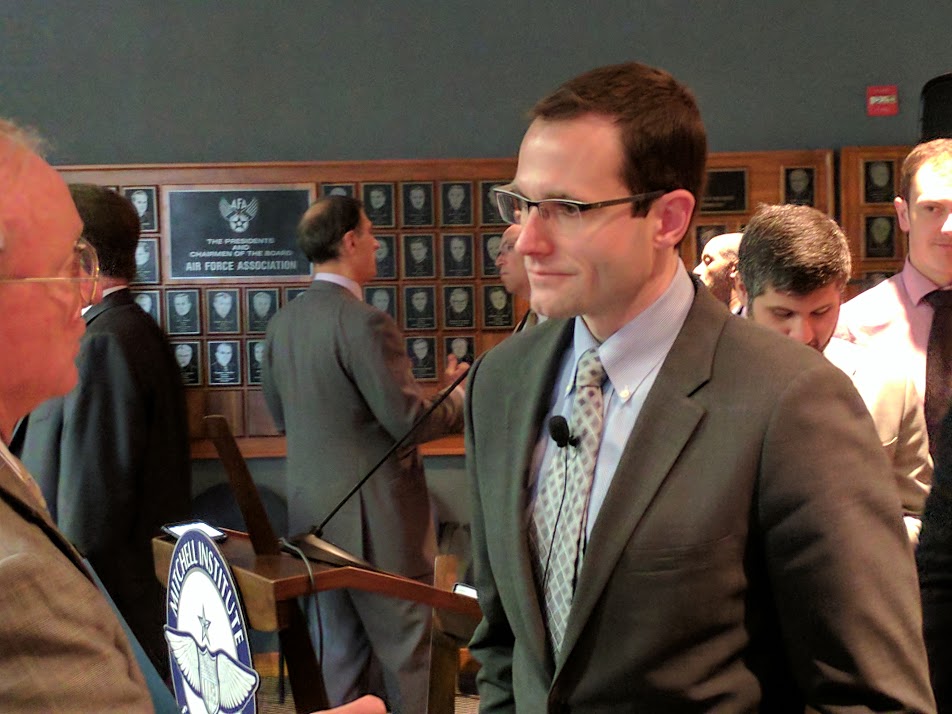
William Roper, director of the Strategic Capabilities Office, argues USAF must increase its use of data in decision making at an AFA Mitchell Institute event in Arlington, Va., on March 28, 2017. Staff photo by Gideon Grudo.
The Air Force needs to switch into a data-centric mindset, but humans must remain at the center of warfighting decision making, according to the head of the Defense Department’s Strategic Capabilities Office.
Speaking at an AFA Mitchell Institute event, SCO Director William Roper outlined his vision for USAF’s techno future and challenges, as well as potential solutions. Roper told attendees his “biggest fear” is that the military only deploys perfect solutions.
“We have to change that pace or we won’t be relevant,” he said on Tuesday. Roper cited the recently deployed and realigned SM-6 (a Navy missile defense system turned offensive) as an example of a capability that under a normal acquisitions process “would’ve been kicked out for some reason.” In addition to picking up the pace on pushing technology through the pipeline, DOD “can’t take eight years to think about what we should buy,” said Roper, whose office works with all the services on mostly confidential projects. However, Roper tipped his hat to the current acquisitions process, saying it did win the Cold War, and “made a lot of sense for that era.”
He dove deep into the impending relationship between man and machine in future war.
Unlike the other services, USAF generates a lot of data, and that data goes into mission planning, Roper said, which results in battlefield lethality.
“But we’re still focused on data in a 1990s way,” he said. After the fight is fought, the “purpose of the data” is over. “That’s not the way the commercial world [works]— to them, that data is truly gold, or closer to oil,” he said, adding descriptors like “wealth” and “fuel,” to denote how private sector views past data, which he said USAF just tosses. Using that past data, Roper argued, “makes it even more valuable.”
In his mind, in a future conflict, the first day or days of a conflict won’t center on destroying an enemy but almost solely on running missions to gather data about the enemy. Once the data is in USAF’s pockets, Roper said the service has to be constantly churning out ideas and possibilities. Using data only immediately and then not again results in troves of “passive” data, he said, arguing “it needs to be active. It needs to be working for us.”
One of USAF’s challenges in switching into this data-centric mindset, according to Roper, is its dominant capability. In terms of real challenges to USAF, Roper argued “that gauntlet doesn’t appear to be in play for the Air Force.”
“The worst thing is to be in a position where a change is never the most important need today,” Roper said. “We’re going to have to do it before the need is at its crisis.”
Artificial intelligence systems currently imagined by the public—say, a Terminator, for example—aren’t quite where Roper sees the actual future of war heading.
The fact remains that machine learning systems and deep learning systems are still made much stronger with the human touch. When humans are connected to unmanned systems, it “makes them perform better,” Roper said.
“It’s very difficult for [an unmanned system] to make strategic choices—especially outside the dataset on which it’s built,” Roper said, adding those types of choices are what humans are good at doing. “I’m going to need people connected to the machine to help it make choices about a thing it hasn’t seen before.”
This may mean a tactical system will resemble a command hub, a system that flies forward with a human “quarterback.” Technology alone can only go so far for future capabilities, Roper said. It’s interconnectedness that must stay in focus.
“It’s not going to be a dominance gained by technology,” he said. “The US will not tech its way” back into dominance.
